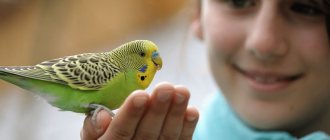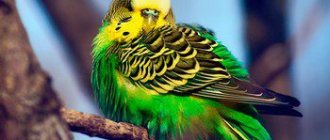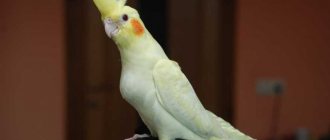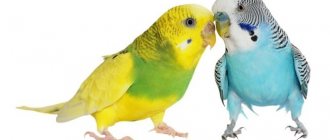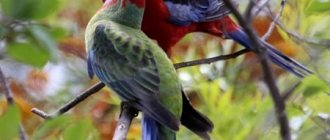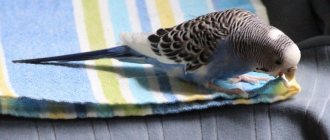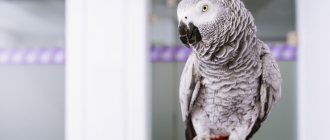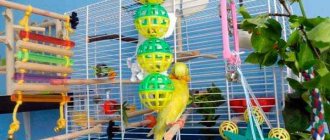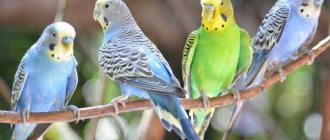Many people try to teach budgies to speak, but such aspirations do not always have results. However, practice shows that these sociable birds become capable students if you communicate with them correctly.
Let's find out how to teach a budgie to talk, and whether all representatives of the breed are able to speak after special training.
Recommended age to start training
Budgerigars become adults by 9–10 months. It has been noticed that young birds cope much more successfully with sound imitation lessons than adults.
Experts believe that the optimal time when a parrot begins to accept training is from 1 to 4 months. While the teenage bird is in the nest, they do not work with it. If a person begins to regularly communicate with a budgie that has been separated from its parents, it will start talking within 3–3.5 months.
Interesting! Even the most experienced trainer cannot quickly teach five-month-old (and older) wavy dogs to talk. This will require several months and a lot of patience from the owner. There will be a result, but only if the parrots have a balanced diet and good care for them.
Do parrots understand the meaning of spoken phrases?
Budgerigars do not put meaning into what they say. This is easy to notice by the way trained birds chaotically pronounce all the memorized phrases.
A parrot is a smart bird, but you still shouldn’t hope that it will learn human speech and have meaningful conversations.
You can complicate the training and teach the parrot words linked to some action. This will take 3-4 times longer than regular phrase training. But the bird will learn to pronounce certain sentences at the moment you need (it will turn out something like a miniature circus act). Here's an example of how to train a budgie to say "Freedom for parrots" when opening its cage:
- You need to speak words to the bird at the moment when it most wants to get out of the cage.
- 3-5 minutes before releasing the feathered “prisoner”, repeat the phrase “Freedom for the parrots” and move the door latch (open and close immediately).
- At other moments (not related to the opening of the cage), do not repeat the phrase so that the parrot remembers its connection to a specific action.
- Do not forget to reward the bird for correctly pronouncing the sentence (as soon as the wavy says it, release the parrot, stroke it and give it a treat).
Budgerigars do not have a very good memory, so they need to repeat memorized phrases every day (if this is not done, then after 1-2 months the training will have to be done again)
Does the ability to speak depend on gender?
All breeders agree that it is much more difficult to teach wavy girls to talk than males.
The owner, who has spent a lot of effort teaching the female to speak, is rewarded with clear pronunciation of words and entire phrases. This is considered a big victory. There are cases when a female taught the correct pronunciation of the words of a male placed next to her.
Conversely, a well-trained boy usually begins to share his skills with a young girlfriend assigned to him.
Interesting! It is much easier to teach a bird to talk if the parrot is alone in a cage. A pair of wavy cats that live together are always busy with each other and it is useless to teach them sound imitation at home.
Set up a contact
During training, do not just mumble a phrase in the presence of a parrot, but contact him, try to build interaction.
- Use emotions. Emotionally charged phrases will be easier for your pet to remember. For example, say your parrot's name affectionately.
- Choose a moment when the bird is in a good mood and ready to make contact. It’s a bad time if the parrot is hungry, excited, doing some of his own business (cleaning feathers, being carried away by a toy or having fun with his fellow tribesmen).
- Be sure to reward the bird with something tasty after exercise. And even more so, encourage success.
As practice shows, birds that live alone, without fellow tribesmen, learn faster, and therefore get used to communicating with humans. But sometimes another parrot, already speaking, can be an assistant in training. If you place a bird that is not yet talking, the new neighbor may soon begin to imitate the “babbler.”
Attention! The bird learns words that you say frequently and emotionally especially quickly, so refrain from frequently repeating curses and other phrases that you would not like to hear from your feathered pet.
Teaching Methodology
Before you begin training with a bird, you should make sure that the parrot is ready for it. It is not recommended to train a newly acquired pet. The bird is given time to adapt, and only after that can you communicate with the budgie and begin training it.
It has been noticed that parrots perceive people with a high-pitched voice better. If the winged pet's teacher is a woman or child, the bird's chances of successfully training will increase significantly. The same person should always handle the parrot - the one whom the pet will get used to considering as its owner.
Table 1. Stages of training a budgerigar
| Stages | Actions |
| Selecting the first (one) word | Most often this is the name of a bird. If it's long, it's better to choose another word. The sound combination should be light and short and contain sibilant consonants. |
| First lesson. Repeating one word | Make eye contact with the parrot. Then slowly and calmly repeat the word several times, observing pauses. If a bird tilts its head and opens its beak, it means it is interested. This is an excellent sign of successful training for this particular parrot. |
| Consolidation. Daily classes for 10–15 minutes | Clear articulation during pronunciation at a slow tempo. Maintaining a sequence of repetitions over several sessions. |
| Increasing pauses between word repetitions | Give the bird the opportunity to repeat the word. The parrot's first responses contain many hissing sounds, creaks and whistles. Later, sound combinations appear that resemble the word. |
| Praise | Give your pet a treat and express your approval with words; if possible, let him fly outside the cage. |
Important! If your pet is upset about something, it is better to postpone the lesson.
It is important to conduct lessons in a quiet environment, with the TV and cell phone turned off. Experts advise removing toys from the bird’s home during the lesson to eliminate moments of distraction. After the lesson, all game attributes return to their places.
The Jaco breed is the smartest breed
Today, the Gray Gray breed is considered the most intelligent family of exotic birds. Parrots of this species have outstanding intelligence and learning skills: they can learn up to 300 words, conduct conscious dialogue, wait for answers and express their emotions. It is worth saying that it was Irene and her friend Alex who made the discovery of this factor - the unique bird showed the whole world how strong its abilities for intelligent life are.
The Gray genus includes several dozen species of feathered beauties, each of which is distinguished by amazing intellectual skills. There is also a division within the gray group itself: among all the representatives of this breed, the most intelligent breed is considered to be the brown-tailed bird.
The level of development of these chicks reaches a 5-year-old child - this is precisely the factor confirmed by the parrot Alex.
Gray birds, which have a keen mind, can not only talk, but also imitate all sorts of extraneous sounds: a runny nose, sneezing, a creaking door, a telephone ringing, noise made by electrical appliances, etc. It is worth understanding that the development of such abilities is the fruit of long and thoughtful work, similar to dog training. With careful attention from the owner, the Gray Gray will become a full member of his family, but if there is no care, the person will receive a grumpy, harmful and difficult to control pet.
Fast way to learn
Teaching birds to sound imitate human speech is a slow and painstaking process. At least 2.5–3 months will pass before the owner of the wavy notices that the pet is talking.
To speed up the results, you should pay attention to the following points:
- During the lesson, the bird should be slightly hungry. This stimulates her activity.
- You should not delay classes so as not to discourage the parrot from wanting to communicate.
- You need to start learning with short words.
- Constantly monitor your pronunciation.
- Do not show aggression towards your pet, even if something doesn’t work out for him.
It has been noticed that budgies learn to speak faster if the owner uses the technique of twice-daily training. Such classes are conducted with a significant period of time between them and last no more than 10–12 minutes. For example, you could have your first lesson at around 9am and your second at around 5pm.
Talking parrots (video)
- Video No. 1
- Video No. 2
- Video No. 3
- Video No. 4
- Video No. 5
- Video No. 1
- Video No. 2
- Video No. 4
- Video No. 5
- Video No. 6
- Video No. 7
- Video No. 11
- Video No. 12
- Video No. 13
- Video No. 15
- Video No. 16
- Video No. 17
- Video No. 18
- Video No. 6
- Video No. 1
- Video No. 2
- Video No. 4
- Video No. 6
- Video No. 9
- Video No. 10
- Video No. 11
- Video No. 13
- Video No. 14
- Video No. 15
- Video No. 16
- Video No. 17
- Video No. 18
- Video No. 19
- Video No. 20
- Video No. 22
- Video No. 4
- Video No. 5
- Video No. 38
- Video No. 39
- Video No. 40
- Video No. 41
- Video No. 42
- Video No. 43
- Video No. 28
- Video No. 27
- Video No. 29
- Video No. 30
- Video No. 31
- Video No. 32
- Video No. 33
- Video No. 11
- Video No. 34
- Video No. 35
- Video No. 36
- Video No. 37
- Video No. 1
- Video No. 2
- Video No. 58
- Video No. 59
- Video No. 60
- Video No. 4
- Video No. 5
- Video No. 8
- Video No. 9
- Video No. 65
- Video No. 66
- Video No. 67
- Video No. 6
- Video No. 10
- Video No. 7
- Video No. 71
- Video No. 8
- Video No. 4
- Video No. 9
- Video No. 10
- Video No. 11
- Video No. 7
- Video No. 5
- Video No. 79
- Video No. 11
- Video No. 12
- Video No. 82
- Video No. 83
- Video No. 84
- Video No. 1
- Video No. 3
- Video No. 87
The flora and fauna of our planet amazes with its diversity of species. The world of animals and birds is especially unique, in which there are representatives of different breeds and species that are most unique both in their appearance and in their behavior and habits. A striking example of this is talking parrots . It would seem that everything seems clear, but it is quite difficult to ignore such a phenomenon. Many of us have heard how parrots talk Of course, not all breeds of parrots can be trained, but, nevertheless, talented individuals exist. If we talk about the most outstanding breeds of “talkers”, then first of all these are gray parrots; such a parrot speaks , clearly repeating verbatim phrases, sayings, poems and even songs that its owner teaches. In addition, he very accurately copies all the sounds he hears, from the characteristic signals of a mobile phone to the barking of a dog and the meowing of a cat. This bird is literally a “talking and singing orchestra.” A prominent representative of this genre is the internet favorite parrot Gregory. You will soon be able to
watch the parrot online Second on the list of the most talented conversational students among parrots is the Amazon parrot (Amazon). This type of parrot is practically in no way inferior to the Gray, except that a little more patience on the part of the owner-teacher is required, but the result is worth it, as evidenced by talking parrots , videos of which you can also watch on our website in the Amazon Makesha section.
The third place of honor is occupied by banal budgies. They are easy to train, but the speech of these birds differs significantly from the speech of Grays and Amazons; they do not have the same clarity, accurate tonal transmission of what was previously heard. Video parrots is a section on our website in which everyone can see how various breeds of parrots actively communicate with their owners, read short poems and sing verses from songs.
If we talk about another breed of parrots - the cockatiel, then these birds, unfortunately, are difficult to train, and if someone manages to teach the birds some basics of spoken language, then for the most part the parrot's speech will have a squeaky tone, in fact, this speech will be similar to human speech, but not clear enough.
There are species of parrots that are either completely difficult to learn to talk, or by nature they are not endowed with such bright abilities and capabilities. These include the Ara parrots. Macaw parrots, if they reproduce sounds, are more of a croaking nature, vaguely similar to human speech, which is why this type of parrot is very trainable. But it is possible to teach cockatoos simple words and sometimes expressions, but this is quite difficult, since these birds are not endowed with special abilities for learning spoken language.
Of course, any person who decides to purchase an Amazon or Gray wants his favorite to be the most talented and capable. After all the parrot , the video of which was watched by the maximum number of Internet users, such as Gregory, did not leave a single person indifferent, and naturally many people dream of such a pet. But it is necessary to remember that any animal, in particular a parrot, requires maximum attention, and the more the owner gives it and trains the bird, the sooner he will get results. Of course, it is difficult to speak unequivocally about the presence of natural learning abilities in each individual individual, because sometimes this factor is influenced by many other factors, such as: the age of the bird, where the bird was purchased and its origin. Parrots will be best trained if they are acquired as very young chicks; older individuals are more difficult to learn.
Download a parrot, which amazes with its vocabulary, and also see what species and how they can speak, what to reproduce and imitate, all this and much more, you will definitely find on our website. Here you can also watch moments of direct communication between the owner and the parrot, the emotional side of the conversation, and the correct presentation of the conversation for the bird. In the video clips, you can see in what conditions a parrot should be kept: the cage, its size, location, filling of the cage and its equipment with all the necessary attributes and devices. As you can see, the learning ability of a bird is influenced by multiple factors, combined with the patience and dedication of a potential or existing parrot owner. The main thing is to perceive your pet as a full-fledged member of your family, as “your little brother” or even as a child, which he, in fact, will be if you acquire a bird at a young age.
Parrots of such well-known breeds as Amazon, Gray, and wavy are distinguished by the presence of a certain level of intelligence; they are able to react to emotions and intonations, and even “pay” their owner in the same coin.
If you are interested in a particular parrot, you can easily download the video you are interested in from our website and the Grigory parrot channel on YouTube, thereby receiving an educational, entertaining and touching video that will definitely help you decide on individual training tactics for your pet.
Is it possible to teach an adult budgie to talk?
Ornithological experts believe that the older the bird, the more difficult it is to work with it in terms of training. It is possible to talk to an elderly male. But older females are no longer amenable to training.
To get a rough idea of the age parameters of a bird, you need to pay attention to its plumage. In young parrots that have not yet undergone their first moult (about 3 months), the feathers on the head have a wavy color until the beak begins.
Signs of young wavy birds are also:
- short tail;
- smooth skin on paws;
- black eyes;
- pale shade of feathers.
Interesting! It happens that adult birds are more talented than young ones. It all depends on the individual characteristics of the parrot.
How to choose a capable one
When purchasing an adult bird, it is better to give preference to potentially talkative individuals. They can be recognized by their specific behavior:
- The parrot behaves calmly and has a good appetite.
- The bird always pays attention to the world around the cage, listens, looks closely and is not afraid of people.
If you work with such a parrot in a calm environment, you will definitely get results. The method of training adult pets is common for birds of any age.
Lifespan
As mentioned earlier, Gray Alex died on September 6, 2007, and his death was very unexpected for all the scientists surrounding the bird. According to statistics, the average individual African gray parrot can live up to 50 years. At the same time, Dr. Irene emphasized that no diseases were found in her ward - the annual medical examination of the bird did not reveal any significant problems in its health.
However, after an autopsy, it was possible to establish that the smartest parrot in the world died from atherosclerosis, a disease that leads to fatal blockage of blood vessels. It was impossible to predict such a situation - the tests showed absolutely nothing, and, as mentioned earlier, gray parrots live for 40-50 years without any problems.
Tips and tricks
When parrots say words or combinations of words, this does not mean that they understand the meaning of what was said. Birds simply imitate a sequence of sounds.
Experts advise that after the first 10–12 lessons you associate the pronunciation of a task word with a specific situation. It is better to choose actions that are repeated day after day. For example, a greeting at a meeting, an invitation to a meal or a swim (“eat”, “swim”, “hello, Kesha”).
Experienced breeders confirm that the main success factors are:
- patience;
- competent approach;
- motivation;
- lack of stress;
- regularity of training.
To consolidate the achieved results, a mirror removed from the cage during training helps a lot. The parrot, who is satisfied with the communication with the owner, immediately begins to “tell” the attribute placed in its usual place about its successes and repeat the memorized sounds.
Birds mistake their reflection for a cute relative, and are happy to share the news with him.
Smart parrot Amazon
The Amazon parrot also has good mental abilities. He is able to learn about 80 words, imitates human speech, copies intonation, and can also imitate various sounds. He is able to pronounce not only words, but can also produce entire sentences.
Amazons are also quite artistic. They funny parody other pets, remember melodies, can sing, and perform various tricks.
Amazons are easy to tame and are very sociable birds. They remember and easily recognize the owner among all family members. Amazons are friendly birds and easily learn new things.
Smart macaw parrot
Among the macaw parrots, there are the largest and most expensive varieties. They are able to remember about 20 words. The macaw has a well-developed intellect. Just like gray parrots, macaws pronounce words quite meaningfully.
Macaws are very artistic parrots. They imitate pets and imitate the sounds they hear. The macaw can also be taught to perform various tricks and play games.
But smart macaws have a complex character. They are touchy and jealous. If a parrot is offended or in a bad mood, it can become aggressive and even bite.
The macaw's voice is sharp and shrill. These are noisy and loud parrots.
